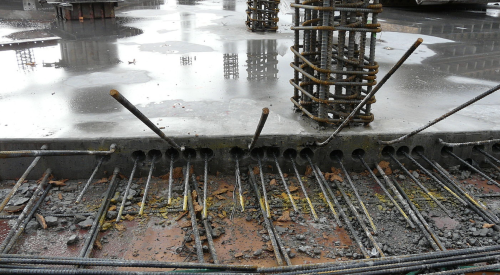|
Not long after John and Mary Brown move into their new home, Mary notices a small hole in one of the window screens. She calls the builder, who promises to take care of it right away. A week goes by, then two. Nothing happens. The Browns interpret this as indifference on the builder's part. The seeds of post-closing disillusionment have been sown.
It's not that the builder doesn't care. He's just busy trying to earn a living, and a damaged window screen doesn't rank very high on his list of priorities. But you'd better believe it's important to the Browns.
The disconnect between builders and homeowners after move-in is a core issue for the home-building industry, says Carol Smith, a renowned customer-service expert. Smith, the founder and principal of Home Address in Colorado Springs, Colo., has worked with home builders for more than 30 years, written numerous articles and books and delivered hundreds of educational programs.
“The builder may say, 'The house isn't falling down; water's not squirting out of the ceiling. It's not a big deal that there's a hole in the screen. I'll get to it when I get to it.'” But when builders fail to attend to such details, “homeowners start making a revenge list,” Smith says.
Delivering the kind of post-closing construction quality that makes customers rave (in a good way) is fraught with challenges. “An awful lot of post-closing experiences are predicated on pre-closing success,” says Dean Potter, vice president of quality and home production processes for K. Hovnanian Cos., Red Bank, N.J. “It starts with the sales process, and ensuring that the customer's expectations are managed correctly.” A builder's pre-closing message needs to be very consistent, Potter says, “because customers talk to each other.”
Kevin Estes agrees. “In order to have a fighting chance for a delighted customer after closing, the home needs to be delivered on time and 100 percent complete,” says the president of Estes Builders in Sequim, Wash. “If not, you're digging out of a hole, and that will be reflected in any post-closing survey results.”
Builders must have a clear vision of what a house looks like when it's complete, Smith says. “That vision needs to be communicated to trades when they're retained and put under contract, and it needs to be demonstrated in the builder's model.”
In general, a complete home is one that has all of its parts. All dirt, dust, carpet threads and lint have been removed. Stickers have been taken off windows and splashes of concrete scraped off patios. Trash has been picked up.
“This really shouldn't be a big mystery,” says Smith. “The problem we get into is that everybody's very busy, and earning the next dollar has become the top priority. That's understandable. But everyone involved needs to recognize that to the homeowner, the last cabinet knob is every bit as important as the roof.”
Cleanliness alone can affect a customer's level of satisfaction, says Chip Pennington, corporate director of customer service in Shea Homes' Phoenix office. “A house can be built perfectly, but if the site is a wreck, the customer associates that with disorganization,” Pennington says. The same goes for post-closing service calls: trade contractors who don't clean up after themselves or don't look professional create a negative perception in the homeowner's mind.
About four years ago, MBK Homes in Irvine, Calif., set new quality standards based on feedback from a member of their accounting department. The woman was purposely chosen because she had no construction experience and would bring a much-needed customer's perspective to the task.
“We got her a high-end camera that could zoom in on a fly speck on a wall or a dimple on a curtain rod,” says Mike Schmidt, vice president of operations for MBK. “She walked the homes, rated them and photo-documented what she saw. The difference between a dirt backyard, not landscaped, and a dirt backyard that had been raked — with the rake grooves showing — turned this company around.”
Shea Homes publishes its quality standards in a warranty manual that is provided to customers at the contract stage. “If a situation arises when the standards need to be referenced, we don't have any surprises,” says Pennington.
MBK Homes is owned by Mitsui & Co., one of the world's oldest and largest trading companies. “As far as our parent company is concerned, we're a Japanese company and should have very high standards of quality,” says Tim Kane, MBK's president. The builder has developed a vast array of procedures and checklists to ensure those standards are met and, as promised, they deliver an “impeccable” home.
Trade contractors are accountable for completing their work properly. Each trade then walks the house with the next scheduled trade to make sure there are no mistakes that will be costly to correct later, says Schmidt. “For example, the plumber puts his ground plumbing in, and before the concrete contractor can pour the foundation, he walks the site with the plumbing foreman, and they measure and verify that the plumbing is coming up in the right walls, the house is trenched properly and the forms are going to work right — before we pour the concrete, because we don't want to rip it out.” Assuming there's nothing to fix, the plumbing foreman signs off on his portion of the work.
In the pre-drywall stage, a red slash is spray-painted over any mistakes. Once they're corrected, a green slash is sprayed in the opposite direction. “You can see in an instant every problem that was there to begin with and how many have been remedied,” Kane says. “It's kind of a badge of honor — you don't want a sea of red on your work.”
In addition to inspections throughout the construction process, MBK does 72-hour and 48-hour walks before delivery. At 72 hours, the superintendent puts a punchlist together, photo-documents the errors and scores the home on quality. At 48 hours, a customer-service representative does the same thing. “We flush the toilets. We run the dishwashers. We overflow the tub to make sure the overflow doesn't leak. We check everything with tissue paper to make sure there's no seeping water,” says Schmidt.
One system that works well, says Smith, involves the superintendent walking the house with a prep team — typically two or three people who are well-trained and well-supplied with tools and materials. Over time, they've developed a list of things to look for, such as making sure all the caulking is done, the cabinet knobs are on, the switchplate screws line up with the switch and so on. “If you've built a pretty good home, these are the things that really make it sparkle,” she says. “A prep team gets very efficient and can usually have a home move-in ready in half a day.”
Calls to customers 30 days and 11 months after move-in have become a standard best practice in the home-building industry, says Estes. “We find it effective to tell the customer about the 30-day call because they're anxious about moving in and have not had any post-closing service,” he says. The check-in is scheduled when the keys are handed over, “because it puts them at ease to know we'll be there after the house is finished.”
Estes goes beyond just checking in during the 30-day visit. “It's an opportunity to do some unsolicited service such as changing a furnace filter, testing smoke detectors and lubricating windows. It's also a good time to hit the high points of the orientation again — to tell them one more time where the water shutoff is and how to request additional service.”
The 11-month call isn't mentioned beforehand. “We prefer this to come out of the blue. It's a great opportunity to delight the customer. We also do a few unsolicited items at this call.”
Estes encourages builders to look for opportunities for additional contact points — such as service reminders, calls or letters — to thank customers and remind them how important they are. “The more touch points, the better,” he says. “It's also not a bad idea to have a customer appreciation event.”
Smith thinks it's important for homeowners to have a sense of control in scheduling the 30-day checkup. “More and more families have both adults working, and people aren't really unpacked after 30 days,” she says. “I recommend giving customers a choice. Tell them you'd like to set up a time to come out somewhere between 30 and 60 days, if that works for them. If the customer says 'No, 81 days would work for me,' then make the appointment for 81 days. There's nothing magic about 30 days; it's just an industry tradition that we need to let go of.”
Ideally, the appointment should be offered to the customer before closing, when it does the most good, says Smith.
Certain things bother the owners of a new home more than others. In Colorado, for example, the short time frame for planting can lead to dissatisfaction with landscaping. “If you close in November, the landscaping may not be installed until May,” says Pennington.
Estes says landscape satisfaction is, in fact, one of the lowest-scoring benchmarks for builders after closing. “Do whatever is practical at the orientation to set reasonable expectations,” he suggests. “A good technique is to take the customer to a yard that was landscaped in the last six to 12 months to show them what to expect at different stages.” In order to keep those expectations at a manageable level, Estes Builders doesn't feature upgraded landscaping in its attached model homes.
Probably the most important aspect of post-closing satisfaction is a speedy and caring response to service requests. “Benchmarking the time from a customer-service request to a personal response from the builder is important, and often overlooked,” Estes says. “The average time to return a customer call should be 15 minutes or less. The time from a request to an appointment to review the problem in the customer's home should be 48 hours or less. The service should be 100 percent completed in one week or less.”
Estes requires a customer-service representative to attend all service calls in order to supervise the work and make sure it's completed within the proper tolerances. “That's why the customer hired us in the first place,” he says. “Leaving the trade contractor to interface directly with the customer is not proper service.”
Builders should periodically review completed service tickets for recurring problems. “The top most common root cause needs to have an action plan to eliminate the cause before or during construction. Then the cause should be re-measured to verify it has been eliminated.” A good benchmark for post-closing service and warranty work is less than $1,000 per home, says Estes.
MBK Homes not only measures customer satisfaction, but also how many surveys are returned, says Kane. “We have one customer-service rep who has had a 100 percent response rate for 11 months, without giving customers any gift certificates or other incentives to fill out the surveys. Once a month, our customer-service department makes a list of the five most common complaints over all projects, and everyone — including me, the vice presidents, the division managers, the field personnel and the salespeople — meets to go over those complaints and discuss what we can do to improve.”
Kane says that over the last 18 months, MBK's most successful initiative to improve pre- and post-closing customer satisfaction has been to appoint a liaison from the corporate office who attends team meetings at each community. “We broke down all the silos and gave the team members a voice for concerns such as 'Don't give me this plumber anymore' or 'Our competitors are doing this in the field and we, as a team, want to offer it in our homes,'” says Kane.
All of this underscores the importance of consistently building a quality home and managing customer expectations. As Pennington says, “If they're not happy at the one-year mark, it doesn't matter how good the builder was up to that point.”
|











